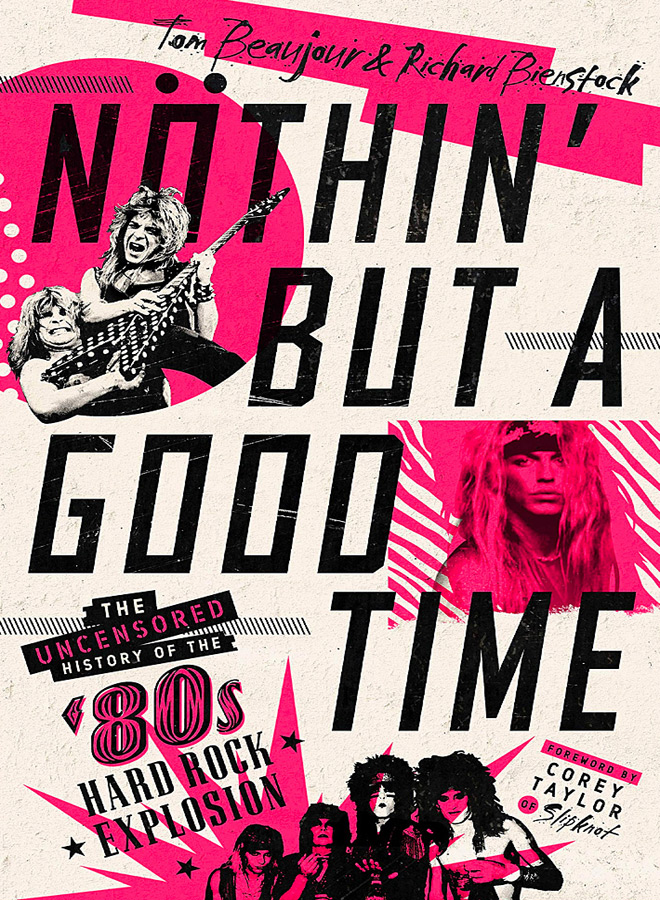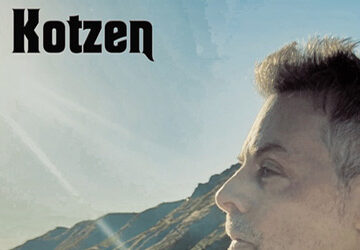Can you resist a deep dive back in time to the decade of decadence? Of course not! So strap on your white leather and tease up those locks, because Nöthin’ But a Good Time: The Uncensored History of the ’80s Hard Rock Explosion is about to take you back to a time when music was a live wire straight to the crotch. St. Martin’s Press delivers the hardcover tome on Tuesday, March 16, 2021.
We open on a foreword from none other than the infamous Corey Taylor of Slipknot and Stone Sour. Relating his childhood experiences with “Mötley fucking Crüe,” the denigrating names for ‘80s Hard Rock, and viewing the scene from a modern perspective to see its flaws, Taylor offers an endearing but honest introduction that refuses to condemn or condone the past. “Every mega-chorus was junk food,” he muses, and clearly we were all addicts.
Still addicts, it seems, authors Tom Beaujour (former editor-in-chief of Revolver) and Richard Bienstock (former senior editor at Guitar World) offer us a collection that is somewhat of “an unruly beast about to turn on its master and engulf them in flames.” At 535 pages, which includes 16 full-color, glossy photo pages, Nöthin’ But A Good Time is quite the undertaking and not intended for a casual fan with a passing fancy.
As such, few stones are left unturned in Beaujour and Bienstock’s comprehensive look at the scene. From artists to managers, the cast of characters is extensive. While this includes obvious titans such as Ozzy Osbourne, Alice Cooper, Dee Snider and David Lee Roth, it’s especially nice to hear from some of the often overlooked individuals that helped to shape Hard Rock, such as Steve Brown (Trixter), Vito Bratta (White Lion), Stevie Rachelle (Tuff), Joe Lesté (Bang Tango), Bruno Ravel (Danger Danger), and many more.
Adding corroborating evidence to the musicians’ stories is a cavalcade of industry insiders, people like former Headbanger’s Ball host Riki Rachtman, actress Christina Applegate (a.k.a. “Kelly Bundy” on Married with Children), “mom” Sharon (SHARON!) Osbourne, Director Penelope Spheeris, producers, publicists, photographers, clothing designers, and many, many more.
And though the research and work put into the book is exhaustive, its format is fairly straightforward: Each chapter is centered around a central topic (say, the formation of Poison) and then each of the contributors provides a quote or two (or three) to help author the narrative; which reads sort of like a Q&A without the question. Additionally, interspersed throughout are short interviews with Michael Anthony of Van Halen, Dave “Snake” Sabo of Skid Row, former MTV Executive Rick Krim, and more.
In short, this is a loving homage to a subgenre that “sounded larger than life and incorporated unforgettable sing-along choruses, chest-beating riffs, cocky swagger, Technicolor glitz, detonated drums” and fleet-fingered guitar gods. Due to the passion put into its pages few topics are ignored, which helps to make a truly impressive history. From trying to rise above the popularity of New Wave and Punk in the late ‘70s to the tragic fire at The Station in 2003, it’s all here. Discussions range across the board, from the deeply serious to the ridiculous, covering issues such as the impact of the drinking age shifting from 18 to 21 to Blackie Lawless’ codpieces to whether or not Nirvana killed ‘80s Hard Rock. Sure, there’s sex, drugs, and alcohol, but there’s also loss, regret, and epiphany.
Perhaps most noteworthy are the tidbits of insider information that you might not have known, such as how Dana Strum (Vinnie Vincent Invasion, Slaughter) turned The Prince of Darkness on to Randy Rhoads, or how, according to Rhoads’ brother Kelle, his mother made Randy attend the audition. Of course we’ve all heard about the infamous Recycler ad that brought Mick Mars and Nikki Sixx together, but did you know that Michael Jackson supposedly ripped off Warrant?
Even though this is far from The Dirt, there’s so much more! For example, on the subject of ridiculousness, Riki Rachtman offers: “Crazy stories? The one that always stands out in my mind is Axl Rose chasing David Bowie down the street saying he was gonna kill him.” (Now we know why Bowie was afraid of Americans!)
Then there was Dee Snider’s manner of handling hecklers. Electric Ballroom host Keith Roth quips, “Dee really fucked people up. I honestly believe that some of those people he singled out are on a couch right now with their therapist talking to them about it.”
We’re given a barricade spot for the totally random, like mentions of Axl Rose rocking assless chaps at a frat party and the Crüe and Ozzy trying to “out crazy” one another, but also the moments of historical importance to the scene. Here, Van Halen receives credit for kickstarting the Sunrise Strip scene, though it’s noted that there was a pivotal importance to the release of Quiet Riot’s Metal Health. We touch on image and MTV, flyer wars, ballads (a.k.a. “panty-droppers”), Penelope Spheeris’ The Decline of Western Civilization II: The Metal Years (1988), the St. Louis Riot, Sebastian Bach’s “performance art,” The Moscow Music Peace Festival, and so very much more.
Much like life it’s not all fun and games, and some chapters might be a little disheartening for fans to read: some old rivalries persist, a few of the men are not so elegant with their words, while still others speak flippantly about the loss of their former friends. It’s hard, too, to read about the talented musicians we lost along the way: Randy Rhoads, Nicholas “Razzle” Dingley of Hanoi Rocks, Robbin Crosby of Ratt, Jani Lane (ex-Warrant), Kevin DuBrow (Quiet Riot), and more.
Nöthin’ But A Good Time does, however, does have its limits. There are definitely focal bands—Quiet Riot, Mötley, Poison, Guns N’ Roses, Warrant, and Faster Pussycat, to name a few—so do not expect to read mentions of every single band that populated the scene. For example, there’s no Tesla, Firehouse, Mr. Big, Shotgun Messiah, Love/Hate, or Southgang, though, oddly, a passing mention of Sleez Beez. While this is apt to disappoint some fans, as is the patchy and non-linear coverage of anything that occurred beyond 1994, it’s hard to fault the authors for drawing the line somewhere. At 500-plus pages, one can only imagine the unwieldy monster that would be created if names like Heaven’s Gate, Kingofthehill, Slammin’ Gladys and Slamhound also made the cut.
What Beaujour and Bienstock do deserve credit for is their attempt at handling the sexism and misogyny within the Hard Rock scene: it’s not whitewashed, but it does not maintain a core focus within the narrative. Thankfully the ladies of Vixen, as well as Lita Ford, chime in here and there, and they are quick to point out the blatant sexism of the time. It’s a precarious line to walk, to not ignore an important topic but to not overshadow the story with moral debate, and care is taken to never condone this behavior. There are, of course, moments where better care might have been taken; but this is meant as a tribute to a time when music was wild, not a condemnation of what happened nearly four decades ago.
In short, Nöthin’ But a Good Time is not a frilly coffee table book that offers endless rare images from the past, but, rather, an intensive swim through what it felt like to be alive and flyering the Sunset Strip in the ‘80s. Favoring candid insight and historic highlights over flashy visuals, it is a collection intended only for those invested in the subject matter, not any reader looking for a quick fix. Case in point, don’t buy the book because you’re a Corey Taylor fan: buy it for the uncensored history that birthed some of the best music (and hair) in your lifetime. For this, Cryptic Rock gives Nöthin’ But a Good Time: The Uncensored History of the ’80s Hard Rock Explosion 4.5 of 5 stars.

Nöthin’ But A Good Time: The Uncensored History of the ’80s Hard Rock Explosion (Book Review)
Category(s)Book ReviewsCryptic RockCrypticRockNewsReviews
Tags'80s Hard Rock2021 bookAlice CooperAxl RoseballadsBang TangoBlackie LawlessBookbook reviewBruno RavelChristina ApplegateCorey TaylorDana StrumDanger DangerDave “Snake” SaboDavid Lee RothDee Sniderflyer warsglamGlam MetalGlam RockGuns N' Roseshair bandsHair MetalHanoi RocksJani LaneJoe LestéKeith RothKelle RhoadsKevin DuBrowLita FordMetal HealthMichael AnthonyMick MarsMTVNicholas “Razzle” DingleyNikki Sixx togetherNöthin' But A Good Time: The Uncensored History of the '80s Hard Rock ExplosionNothin’ but a Good TimeOzzy OsbournePenelope SpheerisPoisonpublished 2021Quiet RiotRandy RhoadsRattRichard BienstockRick KrimRiki RachtmanRobin CrosySebastian BachSharon OsbourneSkid RowSlaughterSt. Louis RiotSt. Martin’s PressSteve BrownStevie RachelleSunset StripThe Decline of Western Civilisation II: The Metal YearsThe Moscow Music Peace FestivalThe Prince of DarknessThe Uncensored History of the '80s Hard Rock ExplosionTom BeaujourTrixterTuffVan HalenVinnie Vincent InvasionVito BrattaVixenWarrantWhite Lion





No comment